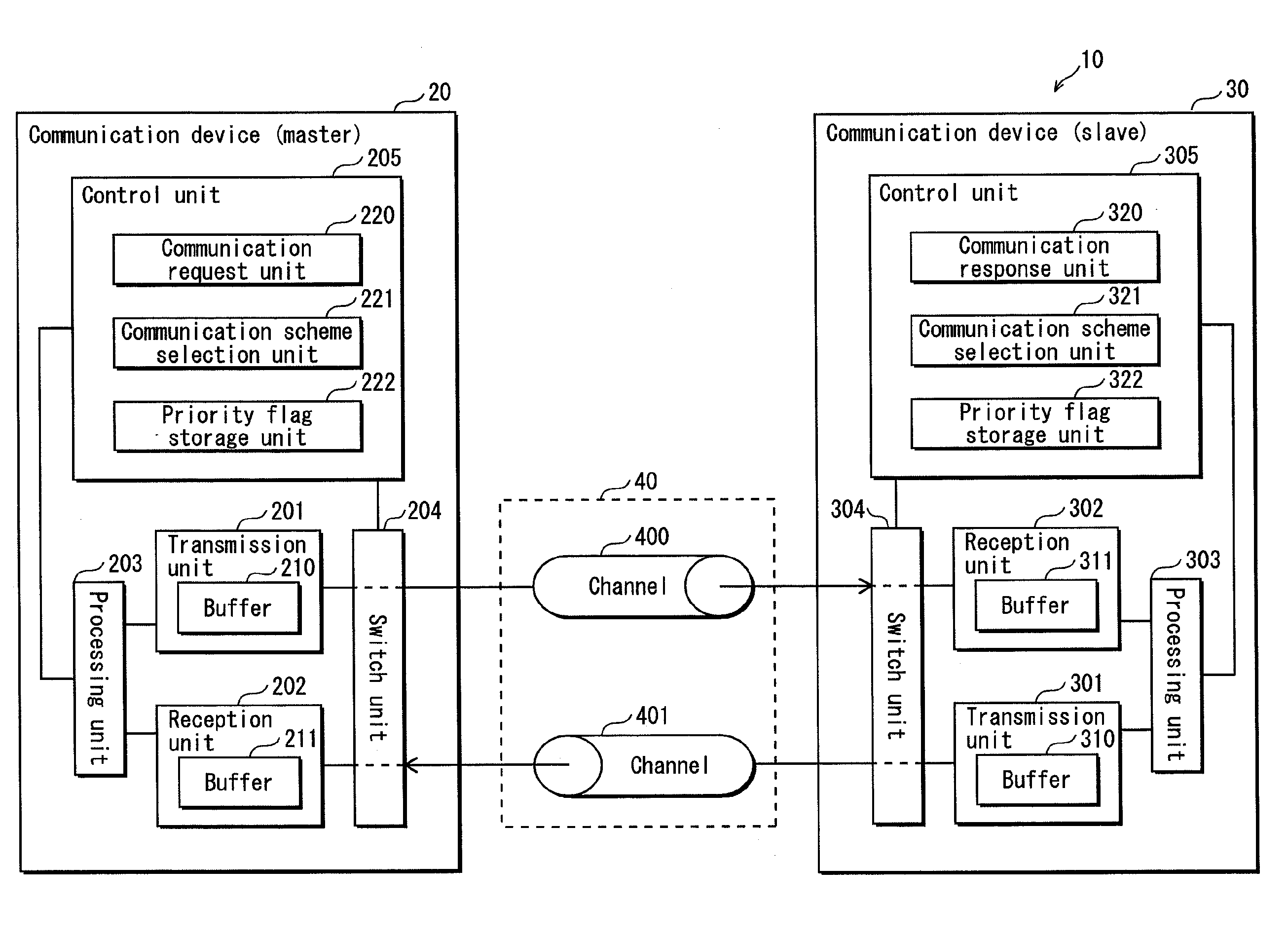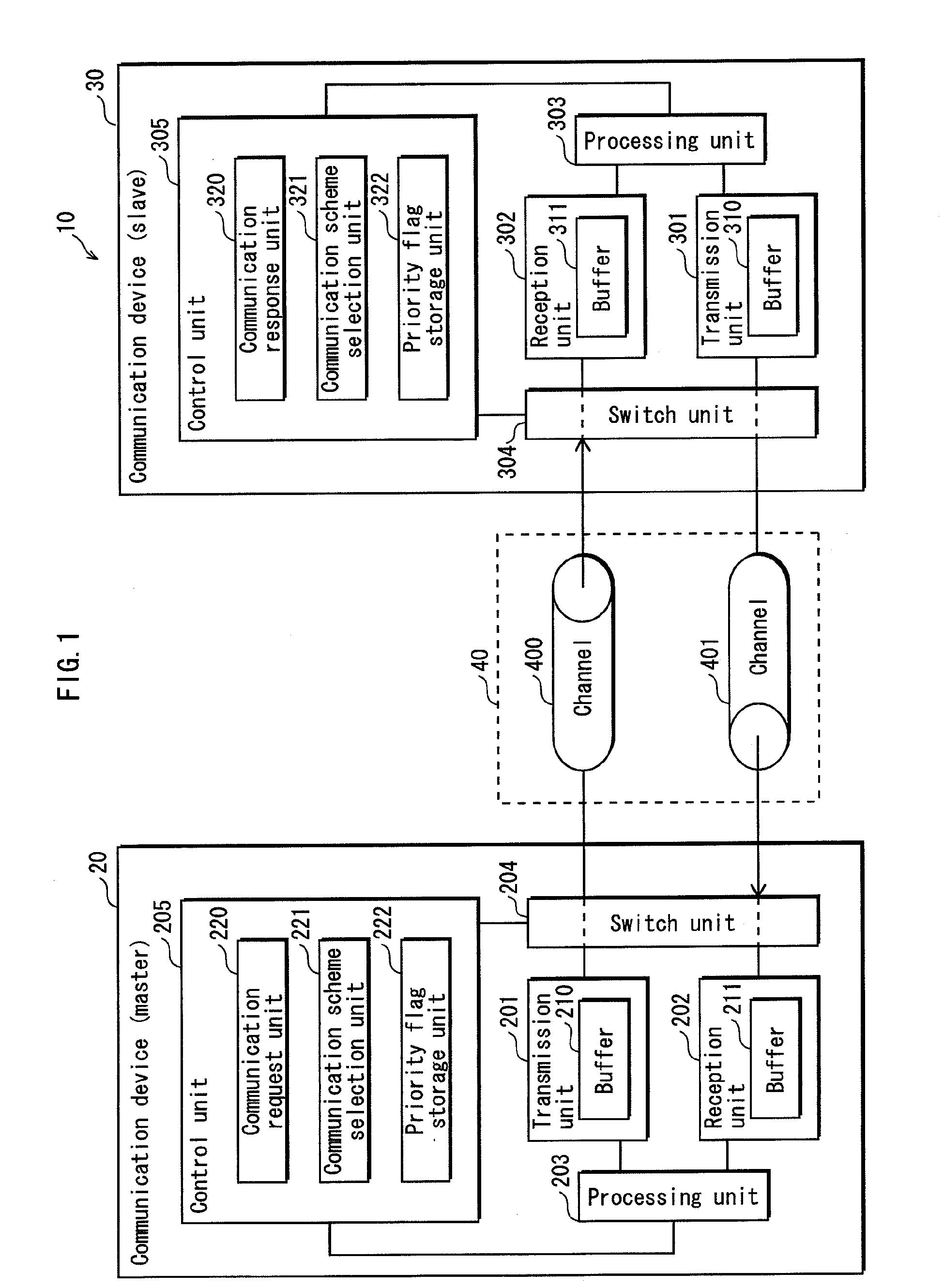[0012]According to the above structure, since each of the first and second devices in the data communication system uses the first communication flag, the second communication flag, and the procedure predetermined between the devices, the both devices are able to select the identical communication scheme. Further, since data communication between the both devices cannot be commenced without
handshaking between the request
signal and the response
signal that determines the communication scheme, the present invention makes it possible to determine the communication scheme conforming to the capability of each of the devices, without an
additional procedure required for determination of the communication scheme. As a result, the occurrence of the underflow of transmit buffer and the overflow of receive buffer as mentioned in the
problem description is suppressed in the data communication system, and therefore data communication is performed without a decrease in communication efficiency.
[0013]Here, prior to generating the request
signal, the communication request unit may generate a priority flag in accordance with the capability of each device, store the generated priority flag in a predetermined first
storage area, and transmit it to the second device, the priority flag indicating either the first device is to take priority or the second device is to take priority in accordance with the capability of each device, upon reception of the priority flag, the
communication response unit may store the received priority flag in a predetermined second
storage area, and the procedure may include the steps of judging whether an indication of the first communication flag accords with an indication of the second communication flag, and when judging affirmatively, selecting a communication scheme in accordance with the indication, and when judging negatively, causing the first and second selection units to select a communication scheme indicated by the communication flag generated by one of the devices which is to take priority, depending on the priority flags stored in the first and second storage areas respectively.
[0014]According to the above structure, since the first and second devices share the priority flag and select the communication scheme according to the indication, it is prevented that the devices select different communication schemes from each other when the indication of the first communication flag differs from the indication of the second communication flag.
[0015]Here, the capability may include a buffer capacity used for data reception, the request signal may include a communication type indicating either that the first device requests to transmit data or that the first device requests to receive data, the communication request unit may judge whether each device has a buffer capacity sufficient enough to secure an amount of data that is to be transmitted in a half-duplex
communication bandwidth, and when judging affirmatively, generate a priority flag indicating that a data transmitting device is to take priority, and when judging negatively, generate a priority flag indicating a data receiving device is to take priority, the first and second selection unit may select, when the priority flag indicates that the data transmitting device is to take priority, a communication scheme indicated by a communication flag generated by the data transmitting device depending on the communication type, and select, when the priority flag indicates that the data receiving device is to take priority, a communication scheme indicated by a communication flag generated by the data receiving device depending on the communication type.
[0016]According to the above structure, when the indication of the first communication flag differs from the indication of the second communication flag, the first and second devices select the communication scheme in accordance with the indication of the communication flag transmitted from either a data transmitting device or a data receiving device, with use of the priority flag determined by the receive buffer capacity in each of the devices. Accordingly, the present invention makes it possible, in the data communication system, to prevent the overflow of the buffer in the receiving device when the priority flag indicates the receiving device, and to make the most use of the send capability of a sending device when the priority flag indicates the sending device.
[0017]Here, the communication request unit may receive information with respect to the capability of the second device, compare the capability indicated by the received information with the capability of the first device, and generate a priority flag indicating that one of the devices having the capability inferior to the other is to take priority according to a comparison result of the initialization unit, and the first and second selection units may select, when the priority flag indicates that the first device is to take priority, a communication scheme indicated by the first communication flag, and select, when the priority flag indicates that the second device is to take priority, a communication scheme indicated by the second communication flag.
 Login to View More
Login to View More  Login to View More
Login to View More 


